We arrived late in Puerto Natales, a small town that apparently exists almost entirely on tourism, to find our way to one of the many residenciales that cater for the backpacker market. The reason this town has found its way onto a map is Torres del Paine National Park, whose granite spires have become a feature of any self respecting trekking guide, and a must see on the Gringo Trail.
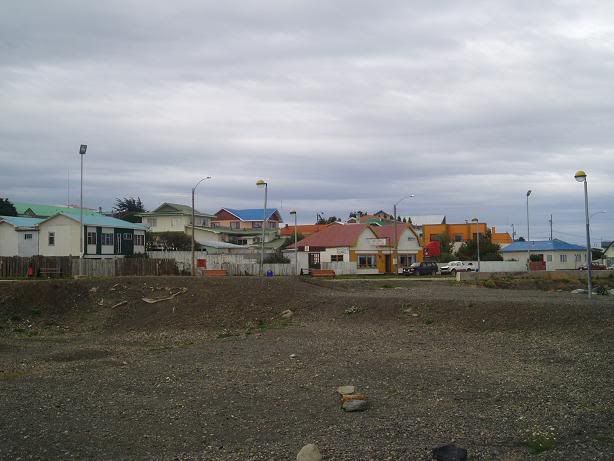
Puerto Natales from the seafront
For all that, Puerto Natales seems like a depressed place - between the hostels, restaurants and internet cafes are empty buildings and open spaces, and the town lacks the kind of vibe I felt in Mendoza and Ushuaia.
With me was Stephanie, a German girl from the Ushuaia, and together we were planning to walk the "W", the most popular trek in Torres del Paine Park. The "W" is basically an east-west trek along the southern edge of the main range, with side trips running north-south up valleys to get views of the mountains. The total distance is around 80km and is normally covered in 5 days - we had to do it in 4 so that Stephanie could get a ferry.
We left Puerto Natales in torrential rain - hoping this was not an omen of weather to come - and covered the 100km or so north to the park to arrive late morning. From the Park entrance it is possible to hike the "W" either east to west, or take a catamaran to the western end of the walk and start there. We took the catamaran - the cloud was so low that I had trouble believing there were any mountains at all, and it was pointless wasting our first day going to look at cloud-covered Torres at the eastern end.
We arrived at our first camp at midday, and in order to do the "W" had to set off immediately on the 24km round trip to Glacier Grey. Without carrying big packs this was quite easy, and in a few hours we were at a mirador (viewpoint), looking out to the snout of the glacier. The glacier is one of many that descends from the southern Patagonian icecap, and it regularly calves icebergs into the freshwater lake. Despite seeing the odd glacier or two in Antarctica, it still made an impression - especially being surrounded by lush vegetation and forrested hillsides.

Glacier Grey descending from Campo de Hielo Sur - the Southern Patagonian icecap
With the cloud as low as it was we were unable to see the glacier as it twisted and climbed it's way back to the icecap - by all accounts a stunning view in the right weather. As it was we headed back after a cold lunch stop in increasingly heavy rain. We returned to camp - fortunately equipped with an indoor kitchen and hot showers - for an early night.
The next morning saw similar weather - constant drizzle and low cloud. I had yet to see any evidence that there were actually any moutains close by; it was rather like walking in Wales on any autumn day, although the vegetation was a lot more alpine in appearance. We walked east to Camp Italiano, a free site with "basic" facilties (i.e. none), situated at the bottom of Valle Frances. Here we pitched camp, and despite advice not to do so, headed north up the valley to try and glimpse some of the surrounding mountains, the eventual target being a mirador just over 2 hours away.
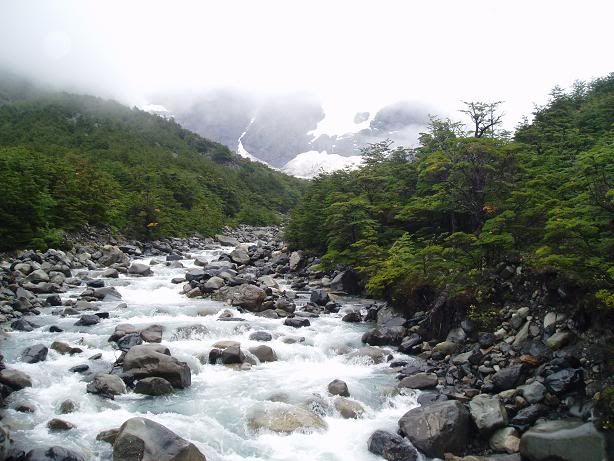
Crossing the river into Camp Italiano - Glacier Frances in background
The way up was not promising; Glacier Frances to the west emerged then disappeared repeatedly from view, whilst north there was just a wall of cloud. We walked through Camp Britanico, just below the lookout, and started up the hill. As if by magic a couple of small patches of blue sky appeared, and suddenly the cloud base lifted enough for us to catch glimpses of Cuerno Principal and Cuerno Norte, in a kind of Lord of the Rings-esque fantasy. There were glimpses of the other hills too - and then they were gone, as if they had never existed, replaced again by an inpenetrable wall of featureless grey.
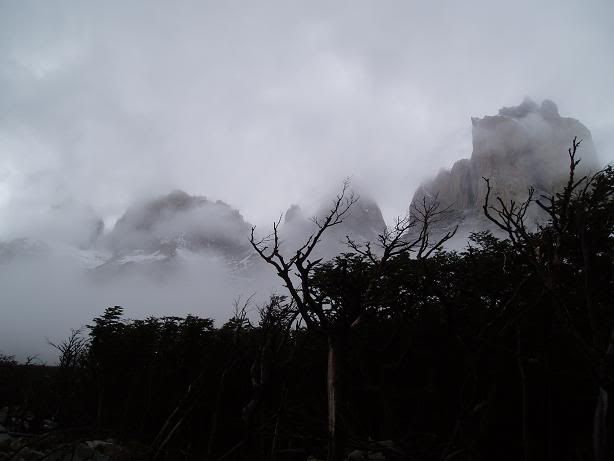
Cuerno Principal emerges from the cloud
Satisfied with our luck we descended back to our damp camp under the trees at Italiano, and had dinner as the rain fell again. Our tent was now pretty much soaked through, and sleeping that night was damage limitation exercise in stopping things getting wet further.
The next morning dawned brighter and, over our instant porridge with chocolate milk breakfast, some blue sky appeared. By the time we had struck camp and started moving east again, there was blue sky in abundance and the sun began to shine. We headed along the north shore of Lago Norgenskold, revelling in the sun. The third day, from Italiano to Camp Torres, was to be the longest - some 22km with full backpacks, and a fair amount of climbing. We passed through Refugio Cuernos, with excellent views of the north of the Cuernos we had been struggling to see the day before. Lunch was an hour later - and it was becoming clear that we might have to move faster to reach Torres camp.
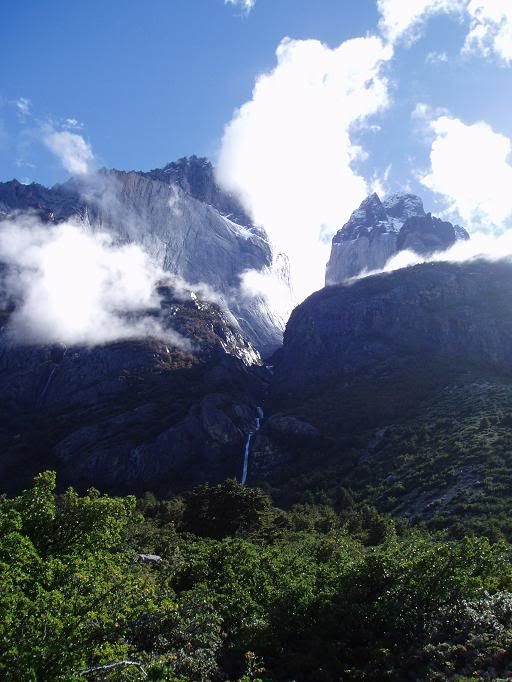
Views over Cuerno Norte and Principal
Two hours later and it was raining again, and Stephanie's knee was beginning to hurt. It had been playing up a bit the past couple of days, but now it was causing persistent pain. There was nothing to do but bandage it and carry on - the rain dampening our spirits of the morning and our will to continue.
By 5 o'clock we had made the decision to camp at El Chileno, a camp about 1 hour lower down the valley than Torres camp, but at a refugio and hence equipped with decent bathrooms and hot showers. We arrived and set up our wet camp, glad that we didn't have to spend much longer being permanently damp. From the camp there were views of the Torres though, our main objective, and as the sun set they were more visible than they had been for several days.
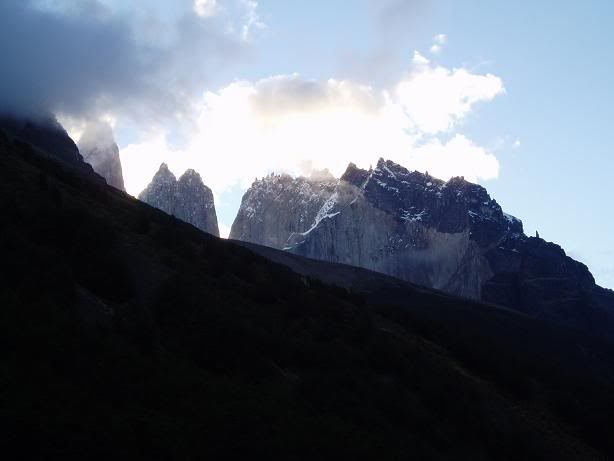
The Torres from El Chileno camp
The next day we had to be back at the park entrance, Laguna Amarga, at 3pm in order for Stephanie to get back to Puerto Natales to catch her ferry. This meant an early start to get to the Torres viewpoint, ostensibly 2 hours away. The best time to see the Torres is sunrise anyway, but given the weather so far we decided to rise at 5.30am and see if it looked worth it.
At 5.30am the night sky was starry and cloudless - the Torres were silhouetted on the horizon to the north west as faint light grew in the east. We left, excited, at 6am as planned, but we soon realised we would not reach the lookout in time for the first light hitting the Torres. I left limping Stephanie to carry the day pack (her suggestion, not mine!) and ran on, getting to Torres camp after 45 minutes then starting the climb up to the mirador. This I managed in 20 minutes - the last part just about on my hands and knees, and as I neared the top I could just see a magnificent pink light illuminating the tops of the Torres.
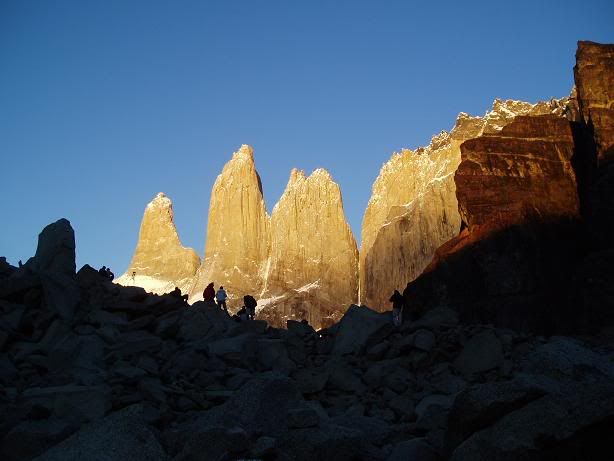
First view of the Torres
I got to the top as the spires were glowing a rich orange colour - as good a possible view as I could ever have expected. The three main granite towers sit above a glacial lake amongst bare rock, with pink and cream strata contrasting with the blue sky behind and reflecting off the stillness of the lake below.
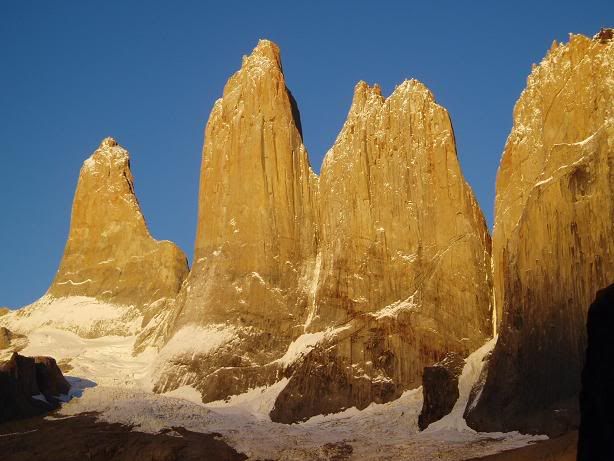
Close-up Torres
There were probably 30-40 people there for sunrise, most gazing in quiet awe at the spectacle, although the 15 or so Israelis present were singing, shouting and generally disturbing the peace. Stephanie arrived at 7.30am, by which time most of the colourful light had gone but the Torres were still more visible than they had been for days. We had our porridge breakfast overlooking the Torres and drying out in the sun that had just arrived at the viewpoint.
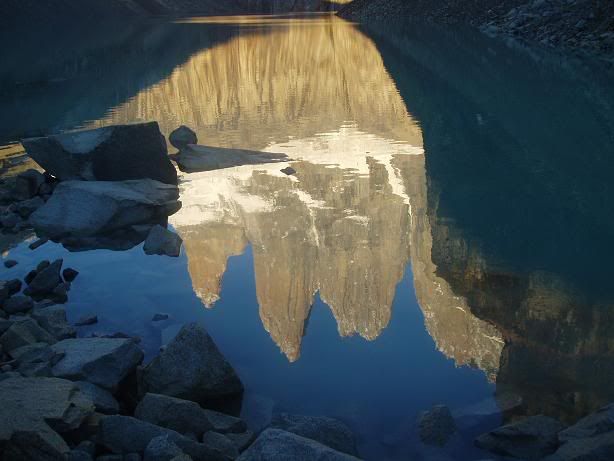
Reflections
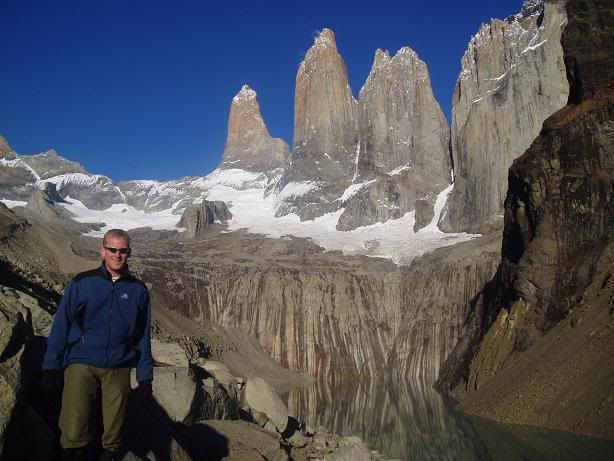
Me and the Torres
Around 8.30am we had to head back down to strike our camp and walk back to the real world. As we packed up the tent we were mostly glad - there wasn't much left in my rucksack that could be called dry - and also thankful that we had had the good fortune to see the Torres at their best.
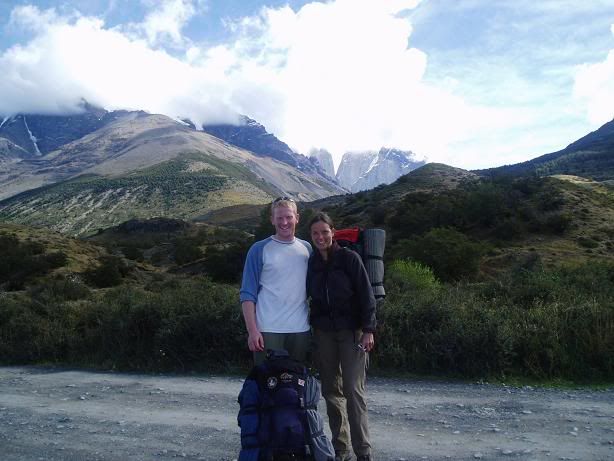
Stephanie and myself at the bottom
The walk down was easy, and in the sunshine it felt like maybe I could continue for another few days. We reached the Las Torres Hostel and had lunch - drying out all our equipment in the sun in front of rooms for which the better off paid $177 a night. There was a bus leaving at 2pm, and after a quick nap in the sun it was suddenly time to go. Driving back to the park entrance we saw evidence o fthe fire that 3 weeks ago had devasted large tracts of the northern and eastern portions of the park. It was for this reason that I had not done the "Circuit", a 120km walk around the whole Paine massif - about 18km were burnt out in a section not known for it's beauty anyway. We got back to Laguna Amarga with enough time for a quick photo stop; somehow in mountains didn't look quite so impressive at this distance, especially shrouded again in cloud. It was best to treasure the morning that we had, I decided, as we boarded another bus back to Puerto Natales.
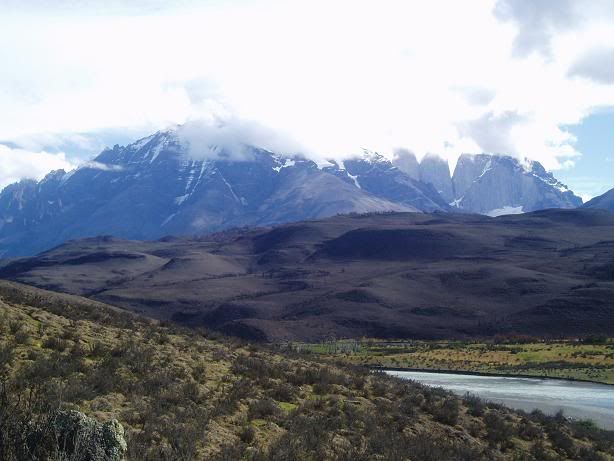
Leaving from Laguna Amarga
Back in Puerto Natales, and the race to get Steph on the ferry slowed down when she discovered she could check in at midnight. We enjoyed a huge meal with Mary, another passenger off the boat, before seeing Steph off and turing in early. I was planning to move on to El Calafate, Argentina, in a couple of days, but woke up with a feeling in my stomach that I would be spending the day in bed with food poisoning - maybe the eggs on the steak the night before had been undercooked.
Another day lost, but some things can't be helped. El Calafate is tomorrow now, and another day in Puerto Natales wasn't so bad. At least it didn't rain.
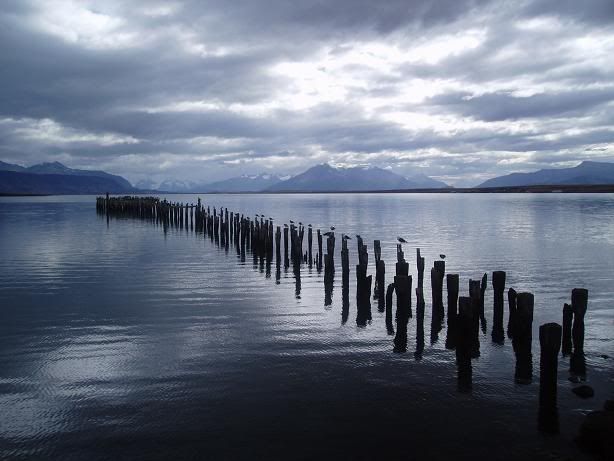
View from Puerto Natales

1 comment:
Hi Pete,
I saw someone on the BBC go on the Antarctic cruise and I wondered if you'd be brave enough to go swimming on the beach! - Should have known! The antarctic looks fantastic though! We've just got back from spending Easter with Jim and Danielle in Inverness- which seemed to be suffering from similar weather to that you encountered on your trek- not many hills or mountains visible! It was lovely to see them though and little Patrick has grown a lot since new year! Anyway, take care and keep posting the great pictures, Claire and Rich x
Post a Comment